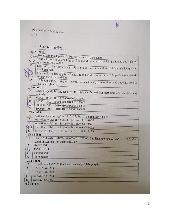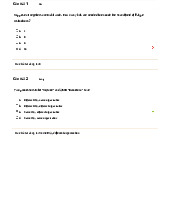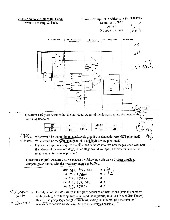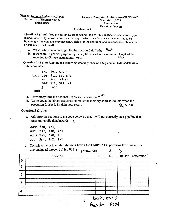



















Preview text:
ELT3047 Computer Architecture Lecture 5: MIPS ISA (2) Hoang Gia Hung
Faculty of Electronics and Telecommunications
University of Engineering and Technology, VNU Hanoi Last lecture review (1)
❑ Applications of design principles to MIPS ISA
➢ Storage model, taking into account compiler consideration ➢ Addressing modes ➢ Instruction encoding
❑ MIPS instruction set examples
➢ Arithmetic & logical instructions. R-type op rs rt rd shamt funct 6 5 5 5 5 6
➢ Data transfer & conditional branch instructions op rs rt Offset (displacement) I-type 6 5 5 16
➢ Unconditional jump instructions op Address Field J-type 6 26 Last lecture review (2)
❑ MIPS instruction set examples (cont.) ➢ If statement. ➢ Loops ➢ Inequalities
❑ Today’s lecture: some more complex operations and compiling from HLL to MIPS assembly
➢ Brief introduction to compiler technology.
Procedure/function call: overview ❑ Procedure/function call
➢ Spy analogy: Leaves with a secret plan, acquires resources, performs the
task, covers their tracks & returns to the point of origin with desired result.
➢ One way to implement abstraction in software ❑ Procedure conventions: ➢ Caller:
▪ passes arguments to callee ▪ jumps to callee Factorial C Code ➢ Callee: int factorial(int n) {
▪ performs the function
if (n < 1) return (1);
▪ returns result to caller
else return n * factorial(n - 1); }
▪ returns to point of call
▪ must not overwrite registers or memory needed by caller
Compiling a procedure call in MIPS
❑ Steps required & architectural support in MIPS Step Description MIPS implementation 1 Place parameters in registers $a0 - $a3 2
Transfer control to procedure & save return address jal, $ra 3 Acquire storage for procedure $gp, $sp, $fp 4
Perform procedure’s operations $t0 – $t9, $s0 – $s7 5
Place result in register for caller $v0, $v1 6 Return to place of call jr $ra ❑ Register usage:
➢ Caller puts arguments in $ a0– $ a3, jumps to callee & simultaneously
saves $PC + 4 in register $ra via the instruction jal &(callee)
➢ Some temporary registers (e.g. $s0 – $s7) must be restored to the values
they hold before the procedure was invoked → spil registers to stack.
➢ When the callee finishes calculations, it places the results in $v0 & $v1, and
returns control to the caller using jr $ra.
MIPS call convention: registers
❑ MIPS register file partition:
➢ $a0–$a3: arguments (reg’s 4 – 7)
➢ $v0, $v1: result values (reg’s 2 and 3) ➢ $t0–$t9: temporaries ➢ $s0–$s7: variables
➢ $gp: global pointer for static data (reg 28)
➢ $sp: stack pointer (reg 29)
➢ $fp: frame pointer (reg 30)
➢ $ra: return address (reg 31)
❑ Register preserving convention:
➢ to reduce register spilling
Preserved (callee-saved/non volatile)
Not Preserved (caller-saved/volatile) Saved registers: $s0-$s7 Temporary registers: $t0-$t9 Stack Pointer: $sp Argument registers: $a0-$a3 Return Address Register: $ra Return registers: $v0-$v1
MIPS call convention: memory layout
Stack = collection of stack frames (aka activation record), each frame
corresponds to a call to a subroutine which has not yet terminated.
❑ Memory allocation for different types of data in HLL
➢ Program code → Text segment
➢ Static/global variables → $gp
➢ Automatic/local variables → $sp, $fp (while managing complex local
variables that do not fit in registers, such as local arrays or structures).
➢ Dynamic data structures (e.g. linked lists) → heap (grows ↑, stack grows ↓) Example: factorial procedure
0x90 factorial: addi $sp, $sp, -8 # make room (2 words) for stack 0x94 sw $a0, 4($sp) # store $a0 0x98 sw $ra, 0($sp) # store $ra 0x9C slti $t0, $a0, 1 # a < 1 ? 0xA0 beq $t0, $0, else # no: go to else 0xA4
addi $v0, $0, 1 # yes: return 1 0xA8
addi $sp, $sp, 8 # restore $sp (pop 2 words) 0xAC jr $ra # return 0xB0
else: addi $a0, $a0, -1 # n = n - 1 0xB4 jal factorial # recursive call 0xB8 lw $ra, 0($sp) # restore $ra 0xBC lw $a0, 4($sp) # restore $a0 0xC0
addi $sp, $sp, 8 # restore $sp (pop 2 words) 0xC4 mul
$v0, $a0, $v0 # n * factorial(n-1) 0xC8 jr $ra # return
Stack layout during factorial execution ⋮ Don’t care $sp $v0=6 $a0 (=3) $sp Frame A $ra (=PC+4) $sp $v0=6 $a0 (=2) $sp Frame B $ra (0xB8) $sp $v0=3 $a0 (=1) $sp Frame C $ra (0xB8) $sp $v0=2 $a0 (=0) $sp Frame D $ra (0xB8) $sp $v0=1 ⋮ ➢
No need for $fp in the example as the stack is adjusted only on entry and exit
of the procedure → can be managed with only $sp. ➢
Stack frame (activation record) appears on the stack whether or not an explicit frame pointer is used. Array and Loop
❑ Access large amounts of similar data (in memory) ➢ Index vs Pointer
Accessing array elements via pointers in a loop Element size
Initialization for result 0x12340010 array[4]
variables, loop counter, and array pointers. 0x1234800C array[3] 0x12348008 array[2] 0x12348004 array[1] 0x12348000 array[0] Label: Work by: 1. Calculating address 2. Load data 3. Perform task Array indexing involves
▪ Multiplying index by element size
Update loop counter and
▪ Adding to array base address array pointers.
Pointers correspond directly to memory addresses Compare and branch.
▪ can avoid indexing complexity Array and Loop: example
❑ Count the number of zeros in an array A
➢ A is word array with 40 elements
➢ Address of A[] → $t0, result → $t8 Zero count C code result = 0; ❑ Compiling: think about i = 0; ➢ How to perform the right while ( i < 40 ) { comparison if ( A[i] == 0 )
➢ How to translate A[i] correctly result++; i++; } Array and Loop: Version 1.0
Address of A[] ➔ $t0 Result ➔ $t8 Comments i ➔ $t1 addi $t8, $zero, 0 addi $t1, $zero, 0 addi $t2, $zero, 40 # end point loop: bge $t1, $t2, end sll $t3, $t1, 2 # i * 4 add $t4, $t0, $t3 # &A[i] lw $t5, 0($t4) # $t5 A[i] bne $t5, $zero, skip addi $t8, $t8, 1 # result++ skip: addi $t1, $t1, 1 # i++ j loop end: Array and Loop: Version 2.0
Address of A[] ➔ $t0 Result ➔ $t8 Comments
&A[i] ➔ $t1 addi $t8, $zero, 0 addi $t1, $t0, 0
# pointer to &A[current] addi $t2, $t0, 160 # end point: &A[40] loop: bge $t1, $t2, end # comparing address! lw $t3, 0($t1) # $t3 A[i] bne $t3, $zero, skip addi $t8, $t8, 1 # result++ skip: addi $t1, $t1, 4 # move to next item j loop end:
❑ Use of “pointers” can produce more efficient code!
➢ Reduces the instructions executed per iteration by 2
Translating and Starting a Program Example C code
int f, g, y;//global variables Many compilers produce int main(void) object modules directly { f = 2; g = 3; y = sum(f, g); return y; } int sum(int a, int b) { return (a + b); Static } linking HLL advantages over assembly ➢
Productivity (concise, readable, maintainable) ➢
HLL disadvantages over assembly
Correctness (type checking, etc) ➢
Portability (run on different HW) ➢ Efficiency? Compiler: overview
❑ Assembler (or compiler) translates program into machine instructions
➢ Most assembler instructions represent machine instructions one-to-one
➢ Pseudo-instructions: figments of the assembler’s imagination, e.g.
move $t0, $t1 → add $t0, $zero, $t1
❑ Provides information for building a complete program from the pieces
➢ Header: described contents of object module
➢ Text segment: translated instructions
➢ Static data segment: data allocated for the life of the program
➢ Relocation information: for contents that depend on absolute location of loaded program
➢ Symbol table: global definitions and external refs
➢ Debug info: for associating with source code Compiler: characteristics
❑ Compilation versus interpretation HLL HLL Compiling Interpreting Machine 10010100 Virtual Machine code 11001101 Machine Running Program code Hardware Outputs outputs Hardware ❑ Characteristics Compiler Interpreter How it converts the input? Entire program at once Read one instruction at a time When is it needed? Once, before the 1st run Every time the program is run Decision made at Compile time Run time What it slows down Program development Program execution
➢ Some languages mix both concepts, e.g. Java.
Compilation vs interpretation illustration Compilation Interpretation Anatomy of a compiler
❑ Frontend (analysis phase)
➢ Read source code text & break it up into
meaningful elements (lexeme) & gen. tokens
▪ token = {type, location} of a lexeme
➢ Check correctness, report errors
▪ e.g. “3x” is an il egal token in C
➢ Translate to intermediate representation
▪ IR = machine-independent language
▪ e.g. three-address code (3AC) ❑ Backend (synthesis) ➢ Optimize IR
▪ reduces #operations to be executed
➢ Translate IR to assembly & further optimize
▪ take advantage of particular features of the ISA ▪ e.g. mult ← sll
Front end stages: Lexical Analysis
❑ Lexical Analysis (scanning) ➢ Source → list of tokens.
Front end stages: Syntax Analysis
❑ Syntax Analysis (parsing)
➢ Tokens → syntax tree = syntactic structure of the original source code (text)




